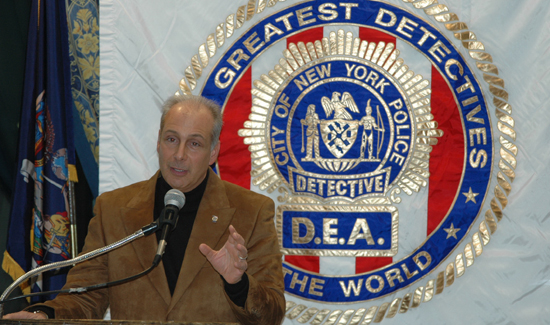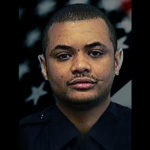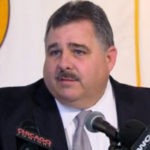The Hard Truth About Cops Who Lie

“There seems to be a big question about faith and confidence in law enforcement not only here in New York City but throughout the country. But cops are human too, and the amount of cases that they handle has to be taken into consideration especially when they’re asked two, three, four, or as many as five years later to recall the specifics of a particular case.” – Michael Palladino, President, Detectives Endowment Association/NYPD
Editor’s note: The National Public Radio affiliate in New York City spent five months studying how often police make false statements in the course of criminal investigations. We thought you would want to read or listen (CLICK HERE). This sort of “report” probably coming to your town if it hasn’t already. The Detectives Endowment Association is a member of PubSecAlliance.
by Robert Lewis and Noah Veltman
Nationwide, the spread of amateur video footage recording police arrests and sometimes the deaths of civilians has cast a harsh light not just on use of force but on officer credibility. Repeatedly, footage has shown the police narrative of incidents to be at best inaccurate.
Last year, New York City’s Civilian Complaint Review Board flagged as many officers for making false statements as it had in the previous four years combined. And the CCRB reports that it’s on pace to have more such cases this year.
With the ongoing national and local discussion about criminal justice reform, WNYC spent five months looking at the issue of police officer credibility to see how often the NYPD’s 35,000 officers are found to distort the truth and what happens to them after.
A review of more than a thousand criminal and civil court cases, and interviews with dozens of attorneys, turned up more than 120 officers with at least one documented credibility issue over the past 10 years. These are mostly officers whose testimony a state or federal judge called unbelievable. Some have apparent fabrications exposed in lawsuits or other records. It’s an incomplete list because state law makes police disciplinary records confidential, and state criminal cases are sealed if the case is dismissed even when it’s due to police misconduct.
Most of these officers stayed on the force. Records show at least 54 went on to make more than 2,700 arrests after the date their word was challenged.
Jonathan Abel is a former fellow at the Stanford Constitutional Law Center who studied access to police disciplinary records across the country.
“There’s just such high stakes that come with an officer’s testimony and people really have been sent to prison and to their death based on the assumption that officers are telling the truth. So it’s critically important that they be honest. That’s just like a job requirement,” Abel said.
“I don’t know why … so many of these cases … involving New York City police officers have to be so fraught with uncertainty.”
U.S. District Judge Raymond J. Dearie
To be sure, most officers on the 35,000-member force testify without ever raising any doubts.
Most of the officers we identified had one adverse credibility finding, and that in itself doesn’t mean an officer is a liar. We don’t know what else is on their record because disciplinary files are confidential.
“We take very seriously at the NYPD any allegation that an officer has testified falsely or even incorrectly,” said Lawrence Byrne, the Deputy Commissioner for Legal Matters.
“It’s very important that we get the facts right.”
Still, in some cases the NYPD ignored red flags regarding an officer’s trustworthiness. And the department failed to put in place fixes recommended for years.
The stakes couldn’t be higher. When an officer distorts the truth, violent criminals can walk free and innocent people can go to prison. More broadly, it undermines trust in the system.
“There seems to be a big question about faith and confidence in law enforcement not only here in New York City but throughout the country,” said Michael Palladino, president of the Detectives’ Endowment Association. “So, when an officer gets caught in a lie—a willful lie—it’s a violation of our oath.
“But…cops are human too, and the amount of cases that they handle has to be taken into consideration,” Palladino said. “Especially when they’re asked two, three, four or as many as five years later to recall the specifics of a particular case.”
A Perjury Charge in the Bronx
Two men were loitering in the lobby of a Bronx apartment building on a Monday afternoon in July 2012 when they caught the attention of an aggressive NYPD narcotics unit monitoring drug dealing in the area. A sergeant in the unit ordered them to step outside.
Detective Greg Larsen later testified that one of the men, Cleveland White, threw an orange prescription bottle full of oxycodone on the ground. Larsen arrested him for drug possession. It seemed like a routine bust for Larsen and the unit, which racked up arrests in buy-and-bust operations throughout the borough.
White denied the charges, but it was his word against Larsen’s. Or so the police thought.
A security camera on the building captured the incident and showed White wasn’t holding drugs in his hand and never threw a pill bottle on the ground.
The charges were dismissed and White filed a lawsuit alleging cops planted the drugs. He’s back in prison on an unrelated drug case and wasn’t available for an interview.
As for Larsen, a grand jury indicted him for perjury in May 2014. The Bronx District Attorney’s Office is quietly prosecuting the case and the charges have never been reported until now.
In court filings, Larsen—who was a first-responder to the World Trade Center on 9/11—said he was exhausted and handling paper work for too many cases when he made the false statements. His criminal defense attorney declined to comment because it’s an active case, and advised Larsen not to talk for this story.
The officers’ alleged suspicion of possible criminal activity appears disingenuous and tailored to meet constitutional objections.
People of New York v. Armando Alvarez
Records show Larsen has been sued at least 16 times, most including allegations of false arrest and brutality. Half of those lawsuits were filed before the arrest that led to the perjury charges. He’s also been the subject of civilian complaints about excessive force and abuse of authority, and was disciplined twice by the department.
Also in 2014, the NYPD conducted an internal disciplinary trial related to the White arrest and found Larsen guilty of making false statements.
In November 2014—six months after his indictment—the department tribunal recommended the commissioner not fire Larsen immediately and instead place him on probation. In the recommendation, Deputy Commissioner for Trials Rosemarie Maldonado cited three other cases where officers made false statements in court and were allowed the keep their jobs.
In December 2014, Commissioner William Bratton—who just months earlier had vowed to root out bad cops—overruled the recommendation and fired Larsen.
The NYPD declined to talk about the Larsen case, or any case involving specific officers.
Palladino, head of the detective’s union, didn’t know about the charges against Larsen. But he said even in the rare cases where a detective faces criminal perjury prosecution, the officer is often vindicated.
“In many cases we are acquitted after a trial. So it just goes to show you, that just because the allegation is raised doesn’t really mean the detective is guilty or not,” Palladino said.
The Miraculous Recovery
In February 2010, NYPD officers recovered a firearm from under the mattress in Frank Hazzard’s bedroom in Brooklyn. The officers lacked a search warrant, but Officer Robert McNamara testified that they had received consent to search from the defendant’s mother, Lola Hazzard, who answered the door at the apartment and invited the officers in.
Defense testimony and hospital records showed that Lola Hazzard, age 76, was actually completely bedridden.
As of February 2010 Ms. Hazzard had not been able to walk unassisted for a year or more.
She suffered from end-stage renal disease, senile dementia, and severe contractures in her legs and hips, and she received care from two aides who fed her, dressed her, and washed her in bed.
Ms. Hazzard was considered to be at activity level “1”—confined to bed.
The judge rejected the search, finding that Ms. Hazzard would have been unable to leave her bed and walk to the front door as claimed by Officer McNamara.
A Long-Standing Concern
The Larsen case is an extreme example — officers rarely face perjury charges. More common are the routine questions raised in court about an officer’s credibility. Judges complain, for instance, that officers tailor their testimony to overcome objections about the legality of a search — for example, alleging drugs were sitting in plain sight when really they were hidden in a car’s glove compartment.
Such shading of the truth was once so prevalent it spawned its own term: “testilying.”
That’s a bit of police vernacular for giving false testimony. It joined the popular lexicon in the mid-1990s, when the Mollen Commission investigated police corruption. The commission found that lying was one of the most pervasive forms of malfeasance in the department, and helped breed an atmosphere where more serious wrongdoing could occur.
“The idea of ‘testilying’ is that officers will lie in order to do what they think is a greater good, which is to get these perpetrators behind bars,” said Professor John Eterno, an associate dean at Molloy College and head of the school’s graduate criminal justice program. “But in fact, what they are doing is violating the constitution and violating the law. And really what I would call violating the social contract between the people and the police.”
He calls it the ‘Dirty Harry’ syndrome, after the 1970’s Clint Eastwood film where a cop uses extra-legal means to get the bad guys.
The manner in which [the officers] presented their testimony … smacked of two very experienced officers well aware of the legal standard for which they were aiming.
USA v. Martese Price
After the Mollen Commission, in 1996, the NYPD adopted a zero-tolerance policy requiring termination for any officer who made a false official statement unless there was an exceptional circumstance. In 2005, the department watered it down so only “intentional” false statements about a “material” matter would get a cop fired. The mere denial of an allegation would not be considered a false statement.
Bottom line: Officers don’t get fired very often for making false statements. In its most recent annual report, released late last year, the Commission to Combat Police Corruption—a permanent body formed in the wake of the Mollen Commission—identified 59 disciplinary cases involving a false official statement where the officer was found guilty. Of those, 41 kept their jobs.
Dick Dadey, executive director of Citizens Union, a good-government group, said the department should bring back the zero tolerance policy.
“It undermines the public trust in the police department when officers are let off the hook for filing false statements,” Dadey said.
“The police department has a credibility problem right now with the community. What does that mean to other police officers into the future? That it’s not important to comply with this law and so sloppiness comes into the system. People aren’t as careful about the things that they say because they’re not going to be held accountable if they make a mistake or say something incorrect or lie about it.”
“A Series of Fantastic Coincidences”
In November 2007, a Fugitive Task Force including NYPD Detective Adam Heege was conducting surveillance in Brooklyn, looking for a murder suspect. Instead, they found Edgar Matos, the suspect’s cousin.
The officers testified that when they attempted to interview Matos, he dropped two bags of cocaine in plain view; they said they then arrested him, and he invited the officers into his apartment.
The officers claimed that once inside, Matos spontaneously blurted out that he had a stash of drugs in a locked cabinet, and offered them permission to search the cabinet and seize the drugs.
The judge ruled that testimony from both Detective Heege and Deputy US Marshal Dennis Tait was not credible and suggested that there were never any drugs dropped on the ground.
I find the officers’ chronicle of events to be a complete fabrication. Each step of the officers’ story defies credibility.
After the judge sided with the defense, the federal government moved to reconsider. The judge affirmed his original finding a year later.
The court remains unpersuaded by the Government’s theory that the evidence against Matos was obtained through a series of fantastic coincidences.
Minding the Gaps
The department has a mock courtroom at its academy to train new recruits on testifying, said Byrne, the NYPD’s Deputy Commissioner for Legal Matters. A Quality Assurance Division helps ensure paperwork is accurate. And Internal Affairs aggressively investigates allegations of false statements.
He also points out that a subjective decision by a judge doesn’t necessarily reflect on an officer’s character.
“Because someone doesn’t remember all the details exactly correctly four or five years after an incident doesn’t mean they’re lying, doesn’t mean they’re trying to shade the truth. It just means they honestly don’t recall the details,” Byrne said.
But he also acknowledges gaps in oversight. Because he is a seasoned officer, he would know the ‘magic’ words to establish probable cause.
People of New York v. Larry Creer
In criminal cases, there’s often a hearing where a judge decides whether to admit or suppress evidence. It’s one of the only times a neutral party publicly assesses the credibility of a police officer. Three-quarters of the officers on WNYC’s list had their testimony deemed not credible after one of these hearings.
Among them were officers in about two-dozen federal cases where a judge let a convicted felon caught carrying a gun walk free. In those cases there appeared to be no dispute the defendant was carrying a gun. Rather, judges often determined officers were lying to cover up an illegal search. The judge tossed the evidence under the Fourth Amendment, which protects against illegal searches and seizures.
“Often when judges make those findings it never comes to the attention of the NYPD, or, in fact, the officer herself or himself,” Byrne said.
He said the NYPD is working with all of the prosecutors’ offices in the city on an automated system so the department will get the findings for review.
“That’s an additional piece of information that we will now look at and decide whether it merits further action. And further action may not be disciplinary action. It may be that the officer just didn’t understand what she was supposed to do when she testifies and got something wrong so it might be a retraining issue,” Byrne said. “Obviously, if it’s deliberate perjury we’re going to pursue that very vigorously with departmental disciplinary charges.”
That automated system has been a long time coming: the Commission to Combat Police Corruption recommended it back in 1999. Byrne said he doesn’t know why it has taken so long, but he’s hoping to get it up and running soon.
Records show that even when the department does know about a credibility issue, it doesn’t always take an officer off the street.
In 2012, a Bronx police officer, a 20-year veteran named Luis Rios, pleaded guilty to internal NYPD disciplinary charges that he embellished facts about an on the job injury, made false accusations against coworkers and misled Internal Affairs investigators, according to court records. The plea followed earlier disciplinary issues where he fell asleep on the job and had unapproved outside employment, the records show.
Yet he was allowed to stay on the street and continue making arrests. Legal Aid represented 48 people he arrested after that 2012 plea. Tina Luongo, attorney-in-charge of Legal Aid’s criminal practice, said her attorneys didn’t know about that record until May of this year, when one of his cases landed in federal court and prosecutors there disclosed the disciplinary history to federal defenders.
The federal judge in that case found Rios’ testimony not believable.
That’s when it became public. Rios did not respond to a request for comment and the NYPD would not discuss a specific case.
“I want to stop that guy”
In February 2013, NYPD officers Konrad Zakiewicz, Salwa Jwayyed, and Javier Velez were on patrol in Brooklyn in an unmarked car when they decided to stop Martese Price. Price was arrested after a gun was found in his pocket during the search.
Officer Zakiewicz testified that he had noticed a heavy, non-rectangular object in Price’s pants when they drove by.
The judge found testimony from Zakiewicz and Velez incredible on several key points, aided by photographs that cast doubt on the officers’ version of events.
The Court finds the officers’ observations, particularly those of Officer Zakiewicz, inherently and transparently false.
The day after Price was indicted, Zakiewicz and Jwayyed were involved in a “strikingly similar” arrest when they decided to stop Ronald Mayo.
The officers testified that when they stopped Mayo, he put his arms above his head, which lifted his sweatshirt and revealed a gun sticking out of his waistband.
The judge declined to credit testimony that Zakiewicz and Jwayyed had already seen the gun for a “split moment” before deciding to stop the defendant, in part because neither of them mentioned the gun out loud at any point until it was revealed, despite the obvious safety concerns it would present when conducting a street stop.
I find that Zakiewicz decided to do precisely what he said he wanted to do: stop Mayo. No warning about a weapon was given because none of the law enforcement officers in the car knew or had reason to suspect Mayo had a weapon.
In both cases, the judge suppressed the results of the search.














